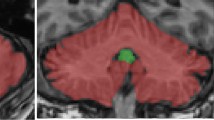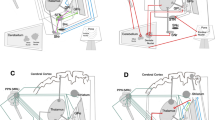Abstract
Deep brain stimulation (DBS) is routinely used in the treatment of Parkinson’s disease, tremor disease, dystonia, and epilepsy. This study aims to establish a hemiparkinsonian monkey model and to investigate the effect of implanted human DBS system for the chronic alleviation of parkinsonian symptoms. Hemiparkinsonism was induced in four rhesus monkeys by unilateral infusion of 1-methyl-4-phenyl-1,2,3,6-tetrahydropyridine. DBS leads were implanted stereotaxically in the right subthalamic (STN) of the monkeys. Subcutaneous extension wires were used to connect the leads to the internal pulse generators (IPG) for stimulation in two of the monkeys (human DBS test group). Post-operative imaging studies confirmed optimal locations of lead contacts. One week later, the IPG was turned on to determine the optimal stimulating parameters, using apomorphine (APO)-induced rotation as a behavioral readout. Animal behavior was scored on a scale of 0–10 over a 12-month period using the modified disability rating scale of hemiparkinsonian monkeys (DRSH). Parkinsonian symptoms in the group of monkeys with DBS improved dramatically (DRSH 3–4) compared to controls (DRSH 7–8). DBS leads were within the STN without intracranial hemorrhage, infection, or other serious complications. Histological examination showed cell necrosis and lymphocytic infiltration of the tissues around the lead and STN gliosis surrounding the lead contact. This study demonstrates that therapeutically effective human DBS systems can be established in relevant disease models in monkeys. Such combination of human DBS systems in hemiparkinsonian monkeys should be valuable in studying the mechanism of action and chronic consequences of DBS therapy in humans.




Similar content being viewed by others
References
Uc EY, Follett KA (2007) Deep brain stimulation in movement disorders. Semin Neurol 27:170–182
Yu H, Neimat JS (2008) The treatment of movement disorders by deep brain stimulation. Neurotherapeutics 5:26–36
Iansek R, Rosenfeld JV, Huxham FE (2002) Deep brain stimulation of the subthalamic nucleus in Parkinson’s disease. Med J Aust 177:142–146
Pahwa R, Wilkinson SB, Overman J, Lyons KE (2003) Bilateral subthalamic stimulation in patients with Parkinson disease: long-term follow up. J Neurosurg 99:71–77
Sanghera MK, Desaloms JM, Stewart RM (2004) High-frequency stimulation of the subthalamic nucleus for the treatment of Parkinson’s disease–a team perspective. J Neurosci Nurs 36:301–311
Schuurman PR, Bosch DA, Bossuyt PM, Bonsel GJ, van Someren EJ, de Bie RM, Merkus MP, Speelman JD (2000) A comparison of continuous thalamic stimulation and thalamotomy for suppression of severe tremor. N Engl J Med 342:461–468
Stefani A, Lozano AM, Peppe A, Stanzione P, Galati S, Tropepi D, Pierantozzi M, Brusa L, Scarnati E, Mazzone P (2007) Bilateral deep brain stimulation of the pedunculopontine and subthalamic nuclei in severe Parkinson’s disease. Brain 130(Pt 6):1596–1607
Volkmann J (2007) Deep brain stimulation for Parkinson’s disease. Parkinsonism Relat Disord 13(Suppl 3):S462–S465
Benabid AL, Chabardes S, Mitrofanis J, Pollak P (2009) Deep brain stimulation of the subthalamic nucleus for the treatment of Parkinson’s disease. Lancet Neurol 8:67–81
Koller WC, Lyons KE, Wilkinson SB, Troster AI, Pahwa R (2001) Long-term safety and efficacy of unilateral deep brain stimulation of the thalamus in essential tremor. Mov Disord 16:464–468
Kumar R, Dagher A, Hutchison WD, Lang AE, Lozano AM (1999) Globus pallidus deep brain stimulation for generalized dystonia: clinical and PET investigation. Neurology 53:871–874
Coubes P, Roubertie A, Vayssiere N, Hemm S, Echenne B (2000) Treatment of DYT1-generalised dystonia by stimulation of the internal globus pallidus. Lancet 355:2220–2221
Vercueil L, Pollak P, Fraix V, Caputo E, Moro E, Benazzouz A, Xie J, Koudsie A, Benabid AL (2001) Deep brain stimulation in the treatment of severe dystonia. J Neurol 248:695–700
Ghika J, Villemure JG, Fankhauser H, Favre J, Assal G, Ghika-Schmid F (1998) Efficiency and safety of bilateral contemporaneous pallidal stimulation (deep brain stimulation) in levodopa-responsive patients with Parkinson’s disease with severe motor fluctuations: a 2-year follow-up review. J Neurosurg 89:713–718
Volkmann J, Allert N, Voges J, Weiss PH, Freund HJ, Sturm V (2001) Safety and efficacy of pallidal or subthalamic nucleus stimulation in advanced PD. Neurology 56:548–551
Greenberg BD, Malone DA, Friehs GM, Rezai AR, Kubu CS, Malloy PF, Salloway SP, Okun MS, Goodman WK, Rasmussen SA (2006) Three-year outcomes in deep brain stimulation for highly resistant obsessive-compulsive disorder. Neuropsychopharmacology 31:2384–2393
Goodman WK, Lydiard RB (2007) Recognition and treatment of obsessive-compulsive disorder. J Clin Psychiatry 68:e30
Franzini A, Messina G, Marras C, Villani F, Cordella R, Broggi G (2008) Deep brain stimulation of two unconventional targets in refractory non-resectable epilepsy. Stereotact Funct Neurosurg 86:373–381
Bauer R, Pohl S, Klosterkotter J, Kuhn J (2008) Deep brain stimulation in the context of addiction–a literature-based systematic evaluation. Fortschr Neurol Psychiatr 76:396–401 (in German)
Stelten BM, Noblesse LH, Ackermans L, Temel Y, Visser-Vandewalle V (2008) The neurosurgical treatment of addiction. Neurosurg Focus 25:E5
Benazzouz A, Hallett M (2000) Mechanism of action of deep brain stimulation. Neurology 55(12 Suppl 6):S13–S16
Shon YM, Lee KH, Goerss SJ, Kim IY, Kimble C, Van Gompel JJ, Bennet K, Blaha CD, Chang SY (2010) High frequency stimulation of the subthalamic nucleus evokes striatal dopamine release in a large animal model of human DBS neurosurgery. Neurosci Lett 475:136–140
Gao DM, Benazzouz A, Piallat B, Bressand K, Ilinsky IA, Kultas-Ilinsky K, Benabid AL (1999) High-frequency stimulation of the subthalamic nucleus suppresses experimental resting tremor in the monkey. Neuroscience 88:201–212
Elder CM, Hashimoto T, Zhang J, Vitek JL (2005) Chronic implantation of deep brain stimulation leads in animal models of neurological disorders. J Neurosci Methods 142:11–16
Dorval AD, Russo GS, Hashimoto T, Xu W, Grill WM, Vitek JL (2008) Deep brain stimulation reduces neuronal entropy in the MPTP-primate model of Parkinson’s disease. J Neurophysiol 100:2807–2818
Zhao XD, Cao YQ, Liu HH, Li FQ, You BM, Zhou XP (2009) Long term high frequency stimulation of STN increases dopamine in the corpus striatum of hemiparkinsonian rhesus monkey. Brain Res 1286:230–238
Zhang J, Wang ZI, Baker KB, Vitek JL (2012) Effect of globus pallidus internus stimulation on neuronal activity in the pedunculopontine tegmental nucleus in the primate model of Parkinson’s disease. Exp Neurol 233:575–580
Schüpbach WM, Chastan N, Welter ML, Houeto JL, Mesnage V, Bonnet AM, Czernecki V, Maltête D, Hartmann A, Mallet L, Pidoux B, Dormont D, Navarro S, Cornu P, Mallet A, Agid Y (2005) Stimulation of the subthalamic nucleus in Parkinson’s disease: a 5 year follow up. J Neurol Neurosurg Psychiatry 76:1640–1644
Breit S, Schulz JB, Benabid AL (2004) Deep brain stimulation. Cell Tissue Res 318:275–288
Hammond C, Ammari R, Bioulac B, Garcia L (2008) Latest view on the mechanism of action of deep brain stimulation. Mov Disord 23:2111–2121
Vitek JL (2008) Deep brain stimulation: how does it work? Cleve Clin J Med 75(Suppl 2):S59–S65
Benazzouz A, Boraud T, Feger J, Burbaud P, Bioulac B, Gross C (1996) Alleviation of experimental hemiparkinsonism by high-frequency stimulation of the subthalamic nucleus in primates: a comparison with l-Dopa treatment. Mov Disord 11:627–632
Bankiewicz KS, Oldfield EH, Chiueh CC, Doppman JL, Jacobowitz DM, Kopin IJ (1986) Hemiparkinsonism in monkeys after unilateral internal carotid artery infusion of 1-methyl-4-phenyl-1,2,3,6-tetrahydropyridine (MPTP). Life Sci 39:7–16
Benazzouz A, Gross C, Dupont J, Bioulac B (1992) MPTP induced hemiparkinsonism in monkeys: behavioral, mechanographic, electromyographic and immunohistochemical studies. Exp Brain Res 90:116–120
Collier TJ, Steece-Collier K, Kordower JH (2003) Primate models of Parkinson’s disease. Exp Neurol 183:258–262
Snider RS, Lee JC (1961) A stereotaxic atlas of the monkey brain (Macaca mulatta). University of Chicago Press, Chicago
Gomez-Mancilla B, Bédard PJ (1993) Effect of nondopaminergic drugs on l-dopa-induced dyskinesias in MPTP-treated monkeys. Clin Neuropharmacol 16:418–427
Goetz CG, Tilley BC, Shaftman SR, Stebbins GT, Fahn S, Martinez-Martin P, Poewe W, Sampaio C, Stern MB, Dodel R, Dubois B, Holloway R, Jankovic J, Kulisevsky J, Lang AE, Lees A, Leurgans S, LeWitt PA, Nyenhuis D, Olanow CW, Rascol O, Schrag A, Teresi JA, van Hilten JJ, LaPelle N (2008) Movement Disorder Society-sponsored revision of the Unified Parkinson’s Disease Rating Scale (MDS-UPDRS): scale presentation and clinimetric testing results. Mov Disord 23:2129–2170
Hu XW, Zhou XP, Jiang XF, Hao B, Wang LX, Cao YQ, Liang JC, Jin AG (20008) Intraoperative verification and adjustment of subthalamic nucleus electrode placement in deep brain stimulation for Parkinson’s disease. J Clin Neurosurg 5:113–116 (in Chinese)
Haberler C, Alesch F, Mazal PR, Pilz P, Jellinger K, Pinter MM, Hainfellner JA, Budka H (2000) No tissue damage by chronic deep brain stimulation in Parkinson’s disease. Ann Neurol 48:372–376
Henderson JM, Pell M, O’Sullivan DJ, McCusker EA, Fung VS, Hedges P, Halliday GM (2002) Postmortem analysis of bilateral subthalamic electrode implants in Parkinson’s disease. Mov Disord 17:133–137
Benazzouz A, Gross C, Feger J, Boraud T, Bioulac B (1993) Reversal of rigidity and improvement in motor performance by subthalamic high-frequency stimulation in MPTP-treated monkeys. Eur J Neurosci 5:382–389
Gimsa J, Habel B, Schreiber U, van Rienen U, Strauss U, Gimsa U (2005) Choosing electrodes for deep brain stimulation experiments—electrochemical considerations. J Neurosci Methods 142:251–265
Acknowledgments
This work was supported by grants from Shanghai Science and Technology Fund (No.10140903400).
Author information
Authors and Affiliations
Corresponding author
Additional information
Y. Cao and P. Yin are co-first authors.
Rights and permissions
About this article
Cite this article
Cao, Y., Yin, P., Hu, X. et al. Chronic high-frequency stimulation therapy in hemiparkinsonian rhesus monkeys using an implanted human DBS system. Neurol Sci 34, 707–714 (2013). https://doi.org/10.1007/s10072-012-1117-7
Received:
Accepted:
Published:
Issue Date:
DOI: https://doi.org/10.1007/s10072-012-1117-7




